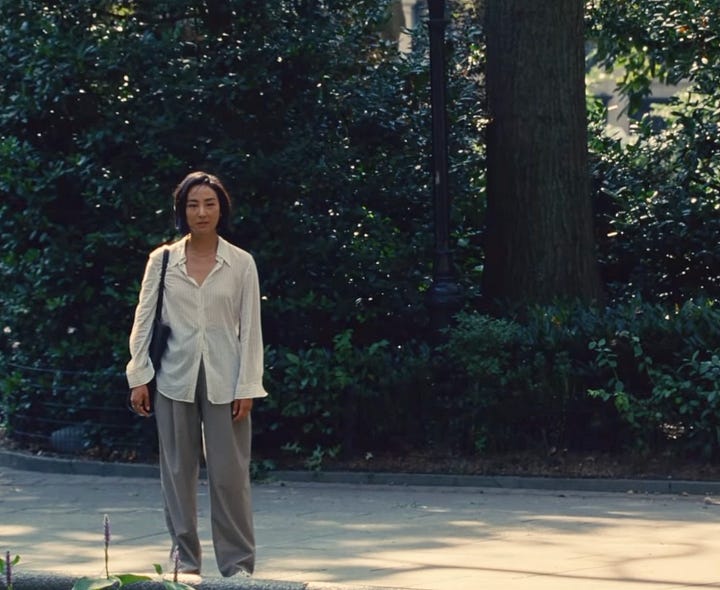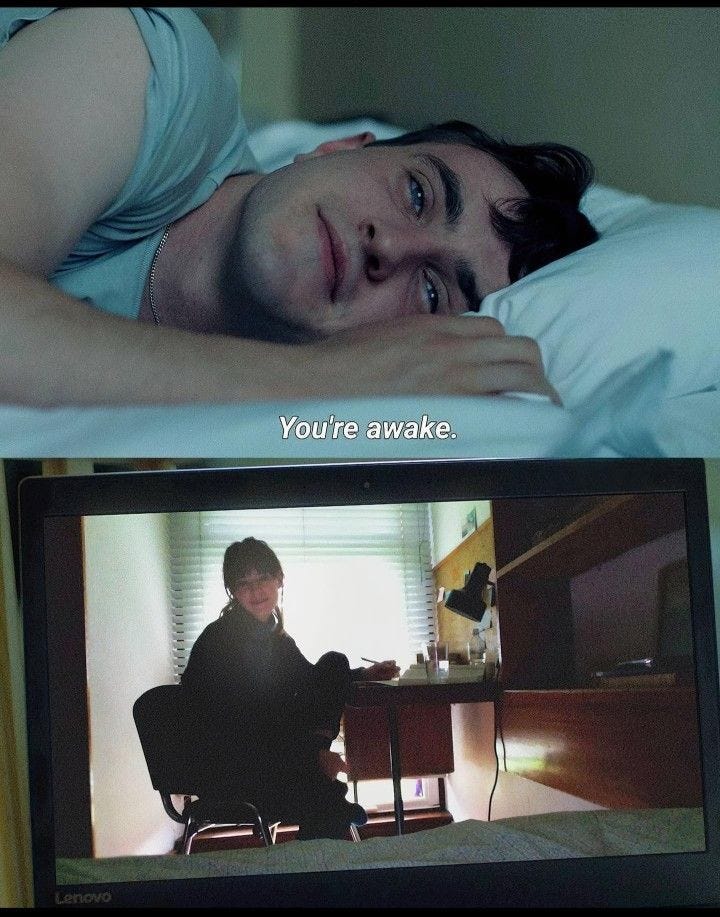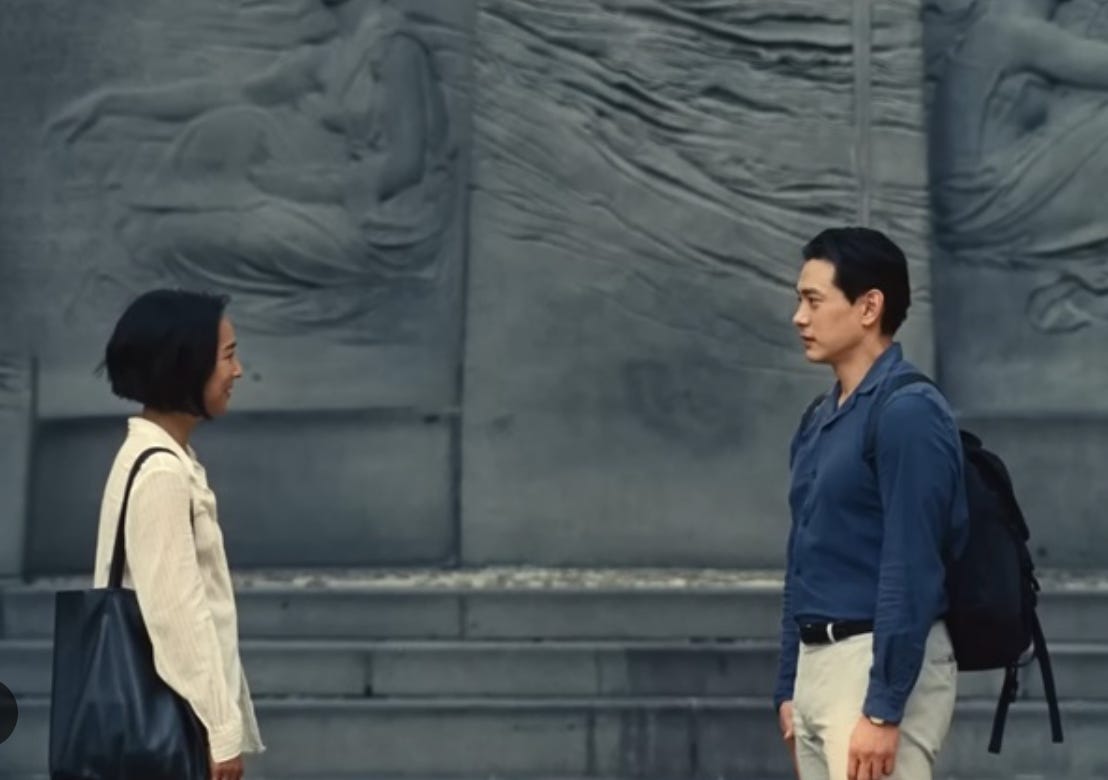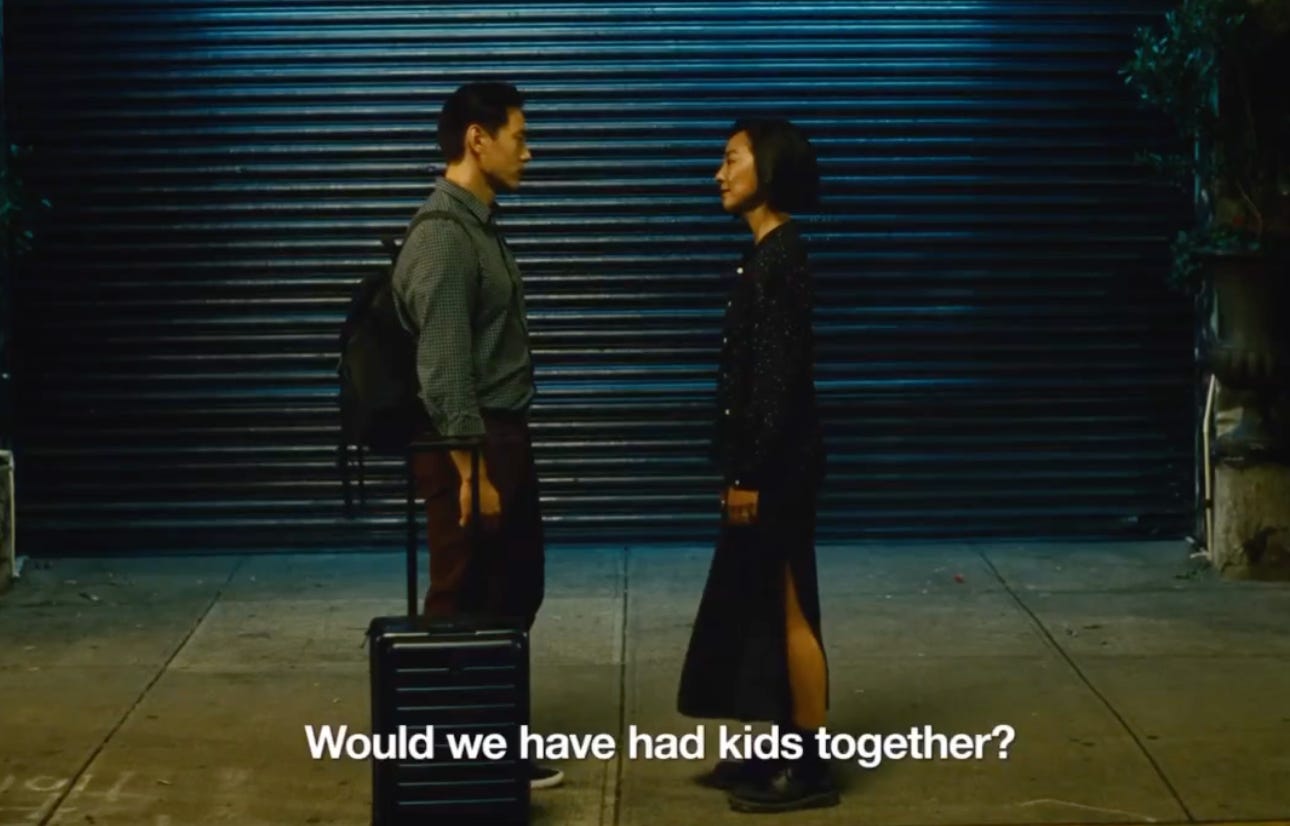This post contains spoilers for the movie.
I was prepared to be emotionally wrecked watching ‘Past Lives’ (starring style icon Greta Lee), but that didn’t make the experience any less intense. When the film started, I nibbled on my buttered popcorn like a hamster, savoring the emotional build up. I gnashed on shiny unpopped kernels with my molars to soothe the emotional tension I felt throughout the movie. In the final scene, I felt a giant frog in my throat and cried more freely knowing that the people around me were crying too and we are communing in our sadness together. The theater is one of the only places a group of strangers can express vulnerable emotions together. Maybe because the darkness lends an armor of anonymity, you are witnessed but not perceived.
Even though this isn’t a Fashion Movie, I loved observing how the clothes develop the characters and emotional landscape. I am organizing my thoughts based on the plot chronology.
Childhood
When we meet Nora and Hae Sung as children, they are walking home from school together. The clothes are simple and rather plain. Jeans, a pullover, a boyish varsity jacket. I interpreted this as a reflection of their middle class social environment, the shared baseline of their time together before their paths diverge. However, Nora is styled with a red turtleneck and red backpack. In costume design, red is often used to signal a character who stands out, someone with a fiery or ambitious streak. This is consistent with Nora’s growth arc as the dreamer with big goals.
This shot shows their first bittersweet goodbye, when Nora leaves with her family to immigrate to Canada. He keeps walking straight and she walks up a flight of stairs, hinting towards her path of growth and change.
College
I could not find ANY film stills from their college long-distance video call era. Please send if you find any! The two childhood friends reconnect over Facebook and start Skyping every day. Nora’s dorm reminded me so much of mine in college. The bed was so Twin XL…
Our protagonists are both in college (Hae Sung serves in the military beforehand). College Nora loves her Niagara Falls Canada tee shirt and Y2k bead necklace. There are shots of her skipping through the streets, rushing home to talk on Skype. She seems like she’s always in motion. I honestly don’t remember what College Hae Sung wore, only that it was a lot of gray and blue and he blended in with his peers. He moved in a slower and more somber way. I think it reflects his years in the military: he got used to wearing uniforms, blending in, moving in a regimented manner.
Writer’s Residency


The year is 2012. Nora meets her future husband Arthur at a writer’s residency in Montauk. She wears cozy casual outfits with a whisper of hippie. The skinny bootcut jean with the Birkenstock Arizonas was very true to 2012. She’s traded her dorm tees for more feminine tank tops, drapey flannels, and chunky knit cardigans. There is a calmness in these scenes. Drinking coffee out of a robin egg’s blue speckle mug. Puttering about the writer’s house with its hardwood floors and airy windows.
Arthur is her match in so many aspects, and it’s shown through his clothes. The same flannel and jeans look, just more masculine. Their color palettes are the same: soft cornflower blues, mauves and rust. They both look comfortable. Their meet cute is gentle and quiet—no grand romancing, no flashy gifts. Their connection is grounded in sense of comfort and safety.
Newly Married


Nora and Arthur move to New York as a newly married couple pursuing their writing careers. We see Nora rushing to Arthur’s book signing in a gray blazer, juggling a tray of coffees and tote bags hanging off her arms, flitting about in a dynamic and haphazard way. They have grown up. Still loyal to their tee shirts but swapping the slouchy flannels for structured chore coats. Him in olive and her in mauve, the same tonal family. In these photos they’re wearing the same chore coats in two different scenes, showing that they rewear their clothes. They’re people who commit to their choices. Their connection is one of repetition and consistency.
This is how East Village Literary People in the 2010s would dress. Arthur’s looks especially lean academic and professorial—decidedly not corporate nor overtly business-y.
They are each other’s mirror image: both wearing shoulder bags on opposite sides. Their jeans look darker than those of their coastal Montauk days, a bit more expensive. Arthur looks like his usual comfy self in the forest green henley. I actually think this top is the most wildcard thing Nora wears in the whole movie. It seems inconsistent with the rest of her character, but I thought about it more and it does looks like a shirt someone would pick out from the Madewell clearance section because they’re still figuring out how to express their style as an adult.
Domestic Life



We get a look into their domestic life, years into their marriage. Their apartment is modest and lived-in, just like their clothes. There’s Mrs. Meyers and Method hand soap on the sink. A surprising lack of pretentiousness (read: not an Aesop household). Personally, when I was introduced to Arthur’s character, I was prepared to dislike him. I craved the confirmation that he was actually a pretentious asshole so Nora would be justified in running off with Hae Sung, but no: he turns out to be consistently compassionate, patient, and understanding. Arthur is so husband. We don’t see much passion or drama in their relationship, but a lot of mundane domesticity in which they chose each other. This is accentuated by the plain pajamas and sweats they wear around each other. The foundation of their relationship is comfort and safety, and we see how they have built a life together.
Reunion


The scene where Nora and Hae Sung reunite after 12 years. Nora looks like she’s fully grown into her adult style. She wears neutral clothes with a nice Olsen Twins slouch to them—maybe she’s buying secondhand Celine off TheRealReal with her playwright salary? The top is loose and languid, the sleeves are intentionally long, the cuffs are unbuttoned. A tote hangs off her shoulder.
This is all in crisp contrast to Hae Sung.


He’s in a navy blue button down, khakis, a belt and a backpack, the straps tightly secured. Essentially an office uniform. Immaculate posture with his hands at his sides (realistic body language for someone who has been in the military, I think). Color wise, his outfit lives in the same world as hers but his is more buttoned up and severe. The backpack stands out against her tote bag. What does he need to carry around?? But at the same time, it evokes the little boy with the backpack she walked home with every day. So in a way, they pick up where they left off as children. As Nora recounts her day with Hae Sung to Arthur, she describes the way he thinks about work and marriage as “very Korean", suggesting their difference in social/cultural conditioning and how they see the world. It comes through in their clothing choices and how they choose to style themselves.
From a costume design and visuals perspective, the clothes are generally pared down in the whole movie to let us focus on the complicated and palpable emotional dynamic. It allows the silent gazes, the stolen glances, the almost-touches to pop.

Dinner & Drinks
They go out for dinner and drinks to see Hae Sung off. This part highlights the complicated tension and awkwardness between the two men as they take turns being the third wheel. I like this shot of the two men side by side, character foils magnified. Arthur in three cozy layers of tee shirt, flannel, and cardigan v. Hae Sung in a work appropriate tucked-in button down. Relaxed v. restrained. Arthur with a 5 o clock shadow and tousled hair, Hae Sung clean shaven with coiffed hair.
Goodbye
The last scene was so, so sad. This goodbye mirrors their first goodbye as kids, as Hae Sung is saddled down by the weight of his backpack and luggage while Nora isn’t carrying anything. He represents the past for her, and in leaving, takes it home with him.
yours truly,
viv









